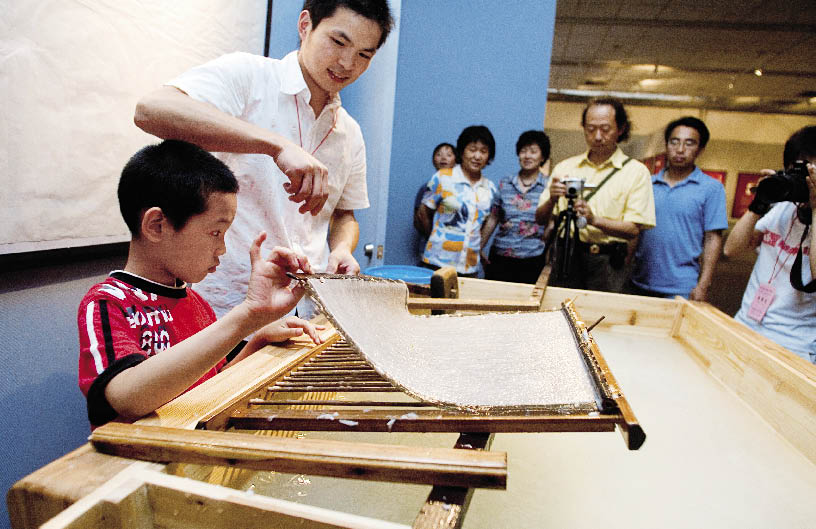|
The traditional skill of making paper by hand has been passed down over generations to today’s papermakers. The full process is comprised of more than 100 steps such as raw material selection, steeping, washing, fermenting, bleaching, pulping, sunning and cutting. To make the paper appear to be naturally white in color, the raw materials need to be washed and starched in natural spring water and then exposed to the open air for a couple of months.
The product is soft and fine in texture, resistant to creasing and corrosion, forming an ideal surface for Chinese artists to express themselves in writing and paintings. Xuan paper is noted for holding ink and water tightly. According to Cao Guanghua, the Master of Arts and Crafts of Anhui Province, the paper’s retentive ability can be traced to its rhombic-shaped fiber (visible under microscope). Cao learnt to make Xuan paper as a youth and his ancestor was one of the earliest papermakers and major producers from the times of the Tang Dynasty. Today, Cao’s family still keeps secret some unique tips for producing the very finest quality of Xuan paper.
Depending on the production process, Xuan paper can be divided into different grades. The unprocessed paper (shengxuan) excels at absorbing water. Ink filters through the unprocessed paper easily. When painting on this kind of paper, people must balance the thickness of the brush and the amount of liquid ink. Unprocessed paper is ideal for Xieyi painting – the freehand brushwork style that uses strokes as simple as possible, so as to resonate with spiritual values.
Shuxuan goes through a process whereby gelatin from animal bones and alum is added to the basic paper mixture. In contrast to shengxuan, the processed paper feels harder to the touch and does not absorb water easily. Hence, shuxuan is suitable for Gongbi painting – the meticulous and realistic style characterized by bright colors and close attention to details.
In between is the half-processed paper that has a neutral character – it absorbs water, but does not filter through easily.
 |
|
Exhibition on traditional papermaking held in National Library of China attracts large numbers of visitors. |
Over the years, Xuan paper has become emblematic of Chinese culture. At the International Exposition held in Panama in 1915, Xuan paper won first prize and hence made its name worldwide.
Even today, Xuan paper is enjoying a great reputation. The skill of papermaking, valued as a national treasure, has also proven an international one; it was listed as a UNESCO intangible cultural heritage in 2009.
Nowadays in Jingxian County, Xuan papermaking is taught in school. Though making Xuan paper by hand is a rather tough job, scores of artisans stick to the manual version of the art so as to maintain the fiber quality, and at the same time, keep the craft alive.
|
